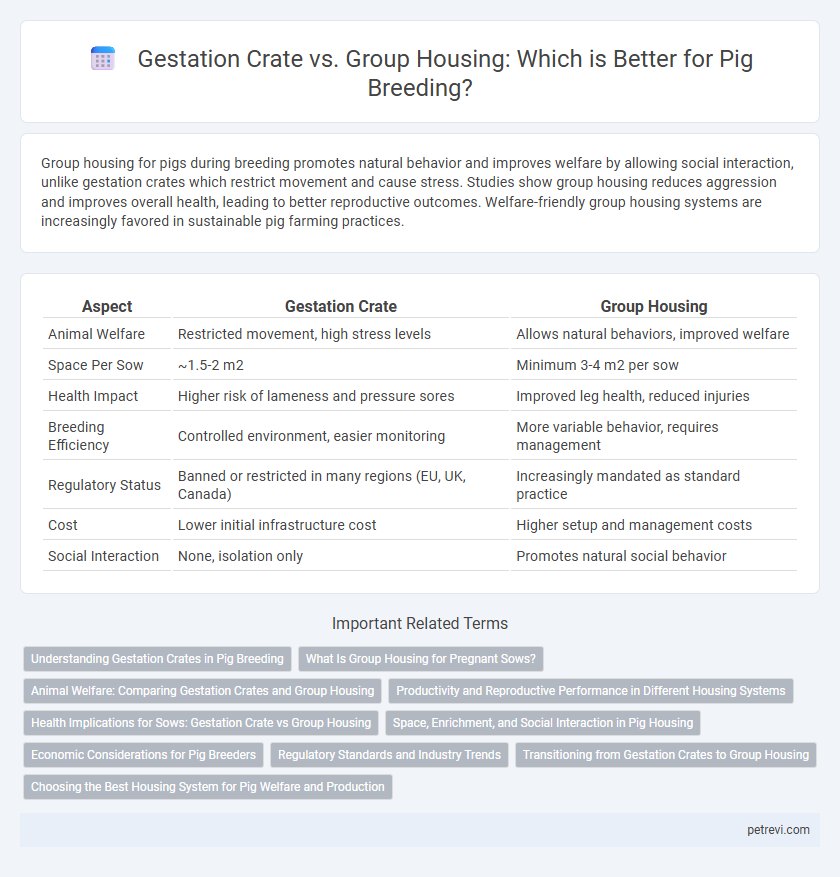Group housing for pigs during breeding promotes natural behavior and improves welfare by allowing social interaction, unlike gestation crates which restrict movement and cause stress. Studies show group housing reduces aggression and improves overall health, leading to better reproductive outcomes. Welfare-friendly group housing systems are increasingly favored in sustainable pig farming practices.
Table of Comparison
| Aspect | Gestation Crate | Group Housing |
|---|---|---|
| Animal Welfare | Restricted movement, high stress levels | Allows natural behaviors, improved welfare |
| Space Per Sow | ~1.5-2 m2 | Minimum 3-4 m2 per sow |
| Health Impact | Higher risk of lameness and pressure sores | Improved leg health, reduced injuries |
| Breeding Efficiency | Controlled environment, easier monitoring | More variable behavior, requires management |
| Regulatory Status | Banned or restricted in many regions (EU, UK, Canada) | Increasingly mandated as standard practice |
| Cost | Lower initial infrastructure cost | Higher setup and management costs |
| Social Interaction | None, isolation only | Promotes natural social behavior |
Understanding Gestation Crates in Pig Breeding
Gestation crates are individual metal enclosures used in pig breeding to confine sows during pregnancy, restricting movement to prevent aggression and injury among pigs. These crates typically measure about 2 feet wide and 7 feet long, allowing only limited repositioning but no turning around, which raises concerns over animal welfare and stress. Studies indicate that group housing systems, where sows can move freely and engage in natural behaviors, promote better welfare outcomes but require careful management to minimize social conflicts and ensure feeding access.
What Is Group Housing for Pregnant Sows?
Group housing for pregnant sows involves keeping multiple gilts or sows together in a shared space during gestation, promoting natural social behaviors and mobility. This system contrasts with gestation crates that confine each sow to an individual stall, often restricting movement and causing welfare concerns. Group housing improves sow welfare by allowing physical activity and interaction, leading to better health and reduced stress during pregnancy.
Animal Welfare: Comparing Gestation Crates and Group Housing
Gestation crates severely restrict sows' movement, causing physical and psychological stress, whereas group housing allows for natural behaviors and social interaction, enhancing overall welfare. Research shows group-housed pigs experience lower stress hormone levels, better muscle condition, and reduced stereotypic behaviors compared to those confined in crates. Welfare assessments increasingly favor group housing for promoting humane treatment aligned with modern animal welfare standards.
Productivity and Reproductive Performance in Different Housing Systems
Gestation crates restrict sow movement, often leading to higher stress levels that negatively impact reproductive performance and overall productivity. Group housing promotes natural behaviors and improved welfare, resulting in better estrus expression and increased conception rates, although it may require careful management to reduce aggression and ensure uniform feeding. Studies indicate that sows in group housing systems typically exhibit higher piglet survival and growth rates, contributing to enhanced long-term productivity in pig breeding operations.
Health Implications for Sows: Gestation Crate vs Group Housing
Gestation crates restrict sows' movement, often leading to increased stress, lameness, and pressure sores, negatively impacting overall health and welfare. In contrast, group housing allows for natural behaviors and increased social interaction, which can enhance muscle tone and reduce stress-related issues. However, group housing may present challenges such as aggression and injury risk if not properly managed with adequate space and enrichment.
Space, Enrichment, and Social Interaction in Pig Housing
Gestation crates limit movement to approximately 0.65 square meters per sow, restricting natural behaviors and eliminating social interaction, while group housing provides at least 2.0 square meters per sow, promoting freedom of movement and social engagement. Enrichment in group housing includes straw bedding and manipulable materials, enhancing mental stimulation and welfare, whereas gestation crates lack such features, leading to stress and stereotypic behaviors. Social interaction in group housing allows pigs to express natural dominance hierarchies and reduces aggression through social bonding, contrasting with the isolation found in gestation crates.
Economic Considerations for Pig Breeders
Gestation crates reduce space requirements and feed costs per sow, resulting in lower immediate expenses for pig breeders compared to group housing. Group housing systems involve higher initial investment due to infrastructure modifications and increased labor for monitoring social interactions but can improve sow welfare and reproductive performance, potentially reducing long-term veterinary costs. Economic considerations must weigh short-term savings from gestation crates against potential productivity gains and consumer demand for welfare-friendly group housing practices.
Regulatory Standards and Industry Trends
Regulatory standards for pig breeding increasingly favor group housing over gestation crates to improve sow welfare, with the European Union and several U.S. states banning or restricting crate use. Industry trends show a growing shift towards group housing systems due to consumer demand for ethically produced pork and advancements in pen design that reduce aggression among sows. These changes reflect a broader commitment to animal welfare while maintaining productivity and compliance with evolving legislation.
Transitioning from Gestation Crates to Group Housing
Transitioning from gestation crates to group housing for pig breeding significantly improves animal welfare by allowing sows to express natural behaviors and engage in social interactions. Group housing systems reduce stress and injury risks compared to individual gestation crates, while proper management, including space allowance and feeding strategies, ensures productivity and health. Research indicates that adapting infrastructure and staff training is essential for a successful transition that balances ethical standards with economic viability in pig production.
Choosing the Best Housing System for Pig Welfare and Production
Gestation crates restrict sow movement, increasing stress and health problems, while group housing promotes natural behaviors and improves welfare. Research shows group housing enhances reproductive performance and reduces lameness and aggression when managed properly. Optimal pig production balances welfare benefits of group housing with careful design to minimize social conflict and ensure feed access.
Gestation crate vs Group housing for Pig breeding Infographic

 petrevi.com
petrevi.com